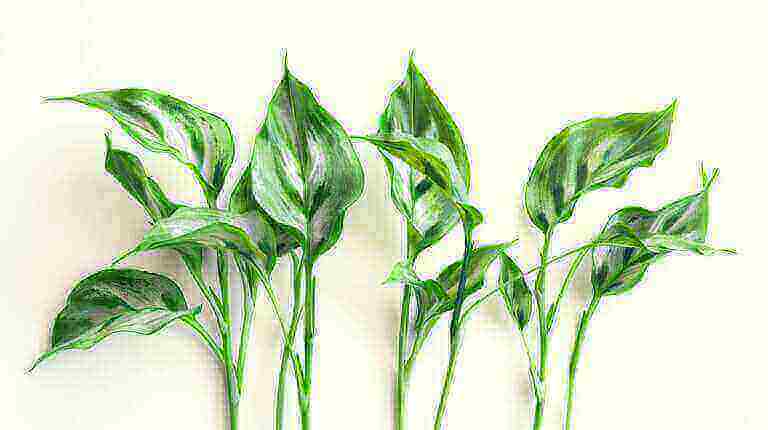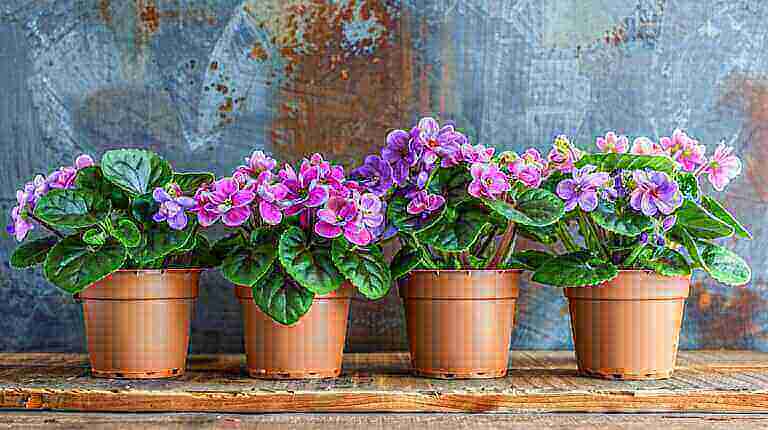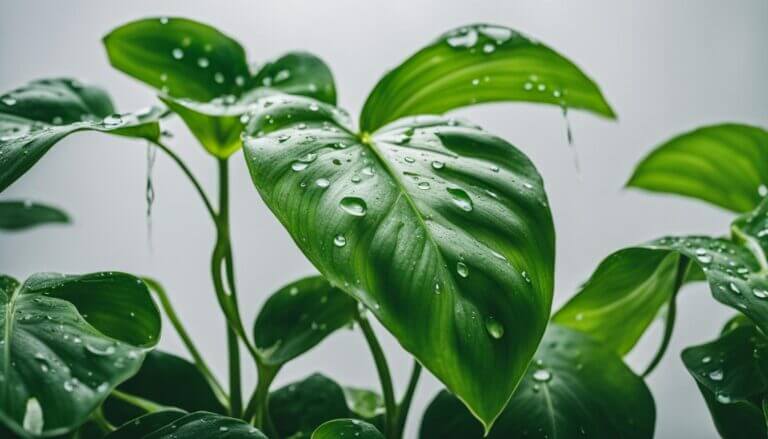Keeping Dieffenbachia and Dumb Canes Plant Healthy Indoors: Dieffenbachia Plant Care Tips
Dieffenbachia plants, also known as dumb canes, are popular indoor houseplants with vibrant and variegated leaves. They are low-maintenance plants that can add a touch of class to any space. To ensure the health and beauty of your dieffenbachia and dumb canes, it’s important to provide them with the right care. Here are some essential tips for indoor plant care:
Key Takeaways:
- Place your dieffenbachia and dumb canes in bright, indirect light.
- Maintain a lightly moistened soil, avoiding overwatering.
- Keep humidity levels high by using a humidifier or DIY humidity tray.
- Avoid exposing the plants to cold drafts or fluctuating temperatures.
- Fertilize regularly during the growing season and rotate the plants for even light distribution.
With these simple care tips, you can ensure that your dieffenbachia and dumb canes thrive indoors and bring life and beauty to your space. Remember, a little care goes a long way in keeping your plants healthy and vibrant!
How to Grow Dieffenbachia and Dumb Canes Indoors
Dieffenbachia and dumb canes are fantastic indoor plants that can add beauty and vibrancy to any space. Growing these plants indoors is relatively easy, as long as you provide them with the right conditions. Let’s explore some essential tips for successfully growing dieffenbachia and dumb canes in your home.
Light Conditions
Dieffenbachia and dumb canes thrive in bright, indirect light. However, they can also tolerate low light levels, making them suitable for various indoor environments. Place your plants in a location where they can receive sufficient light without being exposed to direct sunlight, as this can scorch their leaves. Remember to rotate your plants regularly to ensure even light distribution and prevent sunburn on the leaves.
Temperature and Humidity
Dieffenbachia and dumb canes prefer temperatures between 65°F and 75°F (18°C to 24°C). It’s crucial to avoid exposing them to cold drafts or sudden temperature fluctuations, as these can cause stress and damage the plants. Additionally, these plants thrive in high humidity levels, as they are native to tropical climates. Consider using a humidifier to increase humidity or placing the plants near a tray filled with water and pebbles to create a DIY humidity tray.
Watering and Soil
Proper watering is essential for the health of your dieffenbachia and dumb canes. These plants prefer consistently moist soil, but overwatering can lead to root rot. Check the moisture level of the soil by sticking your finger about 2 inches deep into the soil. If it feels dry, it’s time to water. Use well-draining pots and a well-aerated potting mix to ensure proper drainage. Adjust your watering schedule based on the size of the plants and the season.
Fertilization and Repotting
During the growing season, fertilize your dieffenbachia and dumb canes regularly to provide them with essential nutrients. Use a balanced, water-soluble fertilizer and follow the instructions on the packaging. However, reduce or stop fertilization during the winter months when the plants are in a dormant phase. If your plants outgrow their containers, consider repotting them in the spring. Use a moistened potting mix with proper drainage and ensure that the new pot is slightly larger than the previous one.
Watering Tips for Dieffenbachia and Dumb Canes
Proper watering is essential for the health and vitality of your dieffenbachia and dumb canes. These plants thrive when the soil is consistently moist, but overwatering can lead to root rot and other issues. To ensure you’re giving your plants the right amount of water, follow these watering tips:
- Check the moisture level of the soil before watering. Insert your finger about 2 inches deep into the soil. If it feels dry, it’s time to water. If it’s still moist, wait a bit longer to avoid overwatering.
- Water your plants once or twice a week, adjusting the frequency based on the size of the plant and the season. During the winter months, when growth slows down, reduce the watering frequency.
- Avoid underwatering by keeping the soil consistently moist. However, be careful not to let it become soggy. Proper drainage is crucial to prevent waterlogged roots, so use pots with drainage holes and a well-aerated potting mix.
By following these watering tips, you can ensure that your dieffenbachia and dumb canes receive the right amount of water to thrive.
Maintaining Humidity for Dieffenbachia and Dumb Canes
Dieffenbachia and dumb canes, being tropical plants, thrive in high humidity environments. Maintaining the right humidity levels for these plants is essential to ensure their health and vibrancy. Here are some tips on how to maintain optimal humidity for your dieffenbachia and dumb canes indoors.
Using a Humidifier
An effective way to increase the humidity around your plants is by using a humidifier in the room where they are located. A humidifier adds moisture to the air, creating a more suitable environment for tropical plants like dieffenbachia and dumb canes. Set the humidifier to a level that mimics the natural humidity found in their native habitats.
Creating a DIY Humidity Tray
If you don’t have a humidifier, you can create a DIY humidity tray. Fill a tray with water and place pebbles in it. Set your plants on top of the pebbles, ensuring that the water does not touch the bottom of the pots. As the water evaporates, it increases the humidity around the plants, providing them with the moisture they need.
“Maintaining proper humidity levels is key to keeping your dieffenbachia and dumb canes healthy and thriving.”
Avoid placing your plants near drafts or in areas with dry air, as these conditions can cause the lower leaves to turn yellow and droop. By maintaining optimal humidity levels, you can create a tropical paradise for your dieffenbachia and dumb canes, ensuring they thrive in your indoor space.
| Benefits of maintaining humidity for Dieffenbachia and Dumb Canes |
|---|
| Prevents leaf browning and drooping |
| Fosters healthy growth and vibrant foliage |
| Helps mimic the tropical environment these plants thrive in |
| Reduces the risk of pests and diseases |
| Improves overall indoor air quality |
Common Issues and Troubleshooting Tips for Dieffenbachia and Dumb Canes
When caring for your dieffenbachia and dumb canes, it’s important to be aware of common issues that may arise.
Yellow Leaves:
If you notice yellow leaves on your plants, it could be a sign of both underwatering and overwatering. To troubleshoot this issue, check the moisture level of the soil by sticking your finger about 2 inches deep. Adjust your watering schedule accordingly, ensuring the soil stays consistently moist but not overly wet. If the soil feels dry, it’s time to water; if it’s still moist, wait a bit longer before watering again.
Wilting Leaves:
Wilting leaves can indicate either the need for more water or the presence of root rot. Take a close look at the roots of your plants and remove any infected or rotting roots. If root rot is present, consider repotting the plant in fresh soil. In some cases, wilting leaves may also be a result of exposure to cold drafts or fluctuating temperatures, so make sure your plants are in a stable environment.
Pests:
Dumb canes and dieffenbachia can be vulnerable to pests such as spider mites, mealybugs, and aphids. If you notice any signs of pest infestation, take action immediately. You can manually remove the pests by washing or wiping them off the leaves. For more severe infestations, consider using organic pesticides or seeking professional pest control assistance.
By being proactive and addressing these common issues, you can keep your dieffenbachia and dumb canes healthy and thriving for years to come. Remember to provide the right care, monitor the soil moisture, and address any pests promptly. Troubleshooting these problems will help ensure your plants stay vibrant and beautiful.
FAQ
What are some essential dieffenbachia care tips?
Dieffenbachia, also known as the dumb cane plant, thrives in bright light but can also tolerate lower light. It’s important to water the plant when the top of the soil is dry to the touch. Be careful not to give it excess water as this can lead to drooping leaves.
Can you provide a care guide for a dieffenbachia plant?
Dieffenbachia care involves providing filtered light and watering when the soil is dry. The plant prefers a houseplant fertilizer during the spring and summer for new growth. Always wear gloves when handling the plant due to the sap which contains calcium oxalate crystals.
How do I care for a dumb cane plant?
Dumb cane plants are easy to care for. They need bright light for new leaves to grow but can also survive in lower light. Water the plant when the soil is dry.
What are some tips for caring for dieffenbachia as a houseplant?
As a houseplant, dieffenbachia needs proper care. This includes providing enough light, watering when the top of the soil is dry, and using a houseplant fertilizer for new growth.
How do I care for a dumb cane houseplant?
Dumb cane houseplants are easy to grow with proper care. They need bright light, but can also tolerate lower light. Water them when the top of the soil is dry to the touch.
Why does the foliage of my dieffenbachia plant turn yellow?
Yellowing of dieffenbachia plant’s leaves can be a sign that the plant is getting too much water. Always check that the soil is dry before watering.







